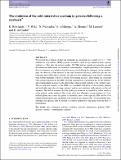Files in this item
The evolution of the cold interstellar medium in galaxies following a starburst
Item metadata
| dc.contributor.author | Rowlands, K. | |
| dc.contributor.author | Wild, V. | |
| dc.contributor.author | Nesvadba, N. | |
| dc.contributor.author | Sibthorpe, B. | |
| dc.contributor.author | Mortier, A. | |
| dc.contributor.author | Lehnert, M. | |
| dc.contributor.author | da Cunha, E. | |
| dc.date.accessioned | 2015-06-25T15:10:04Z | |
| dc.date.available | 2015-06-25T15:10:04Z | |
| dc.date.issued | 2015-03-01 | |
| dc.identifier | 197941298 | |
| dc.identifier | ab4e8a81-782c-4a37-9d4d-73691b7803f7 | |
| dc.identifier | 84946040792 | |
| dc.identifier | 000350273500018 | |
| dc.identifier.citation | Rowlands , K , Wild , V , Nesvadba , N , Sibthorpe , B , Mortier , A , Lehnert , M & da Cunha , E 2015 , ' The evolution of the cold interstellar medium in galaxies following a starburst ' , Monthly Notices of the Royal Astronomical Society , vol. 448 , pp. 258-279 . https://doi.org/10.1093/mnras/stu2714 | en |
| dc.identifier.issn | 0035-8711 | |
| dc.identifier.other | BibCode: 2015MNRAS.448..258R | |
| dc.identifier.uri | https://hdl.handle.net/10023/6866 | |
| dc.description | VW and KR acknowledge support from the European Research Council Starting Grant SEDmorph (P.I. VW). | en |
| dc.description.abstract | We present the evolution of dust and molecular gas properties in a sample of 11 z ˜ 0.03 starburst to post-starburst (PSB) galaxies selected to span an age sequence from ongoing starburst to 1 Gyr after the starburst ended. All PSBs harbour significant molecular gas and dust reservoirs and residual star formation, indicating that complete quenching of the starburst due to exhaustion or expulsion of gas has not occurred during this timespan. As the starburst ages, we observe a clear decrease in the star formation efficiency, molecular gas and star formation rate (SFR) surface density, and effective dust temperature, from levels coincident with starburst galaxies to those of normal star-forming galaxies. These trends are consistent with a natural decrease in the SFR following consumption of molecular gas by the starburst, and corresponding decrease in the interstellar radiation field strength as the starburst ages. The gas and dust contents of the PSBs are coincident with those of star-forming galaxies and molecular gas-rich early-type galaxies, and are not consistent with galaxies on the red sequence. We find no evidence that the global gas reservoir is expelled by stellar winds or active galactic nuclei feedback. Our results show that although a strong starburst in a low-redshift galaxy may cause the galaxy to ultimately have a lower specific SFR and be of an earlier morphological type, the galaxy will remain in the `green valley' for an extended time. Multiple such episodes may be needed to complete migration of the galaxy from the blue- to red sequence. | |
| dc.format.extent | 22 | |
| dc.format.extent | 4597641 | |
| dc.language.iso | eng | |
| dc.relation.ispartof | Monthly Notices of the Royal Astronomical Society | en |
| dc.subject | Dust | en |
| dc.subject | Extinction | en |
| dc.subject | Galaxies: evolution | en |
| dc.subject | Galaxies: interactions | en |
| dc.subject | Galaxies: ISM | en |
| dc.subject | Galaxies: starburst | en |
| dc.subject | Submillimetre: galaxies | en |
| dc.subject | QB Astronomy | en |
| dc.subject | QC Physics | en |
| dc.subject | 3rd-DAS | en |
| dc.subject.lcc | QB | en |
| dc.subject.lcc | QC | en |
| dc.title | The evolution of the cold interstellar medium in galaxies following a starburst | en |
| dc.type | Journal article | en |
| dc.contributor.sponsor | European Research Council | en |
| dc.contributor.institution | University of St Andrews. School of Physics and Astronomy | en |
| dc.identifier.doi | 10.1093/mnras/stu2714 | |
| dc.description.status | Peer reviewed | en |
| dc.identifier.url | http://adsabs.harvard.edu/abs/2015MNRAS.448..258R | en |
| dc.identifier.url | http://arxiv.org/abs/1412.6090 | en |
| dc.identifier.grantnumber | ERC-2012-StG-20111012 | en |
This item appears in the following Collection(s)
Items in the St Andrews Research Repository are protected by copyright, with all rights reserved, unless otherwise indicated.

